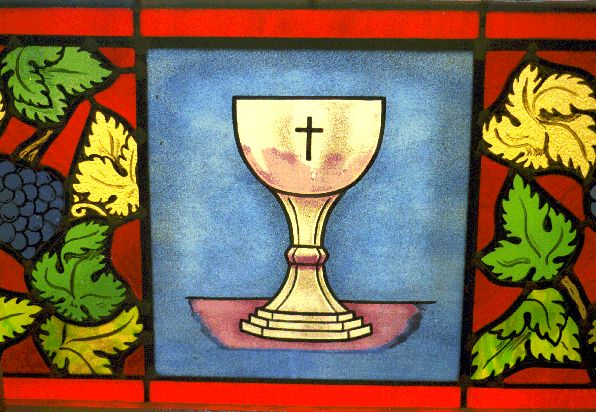Luther’s Theology of the Lord’s Supper
In the medieval period before the Reformation, the mass formed the centerpiece of Christian worship and devotion. Three centuries before Luther began teaching in Wittenberg, the fourth Lateran council of 1215 established the doctrine of transubstantiation, which holds that upon the priest’s consecration of the bread and wine, the accidents (according to the senses) remain the same, but the substance (the internal “essence”) is miraculously transformed into the physical body and blood of Christ.
The implications of this doctrine were widespread. Laypeople began to adore the bread and wine from afar or superstitiously carry pieces of bread back home to plant in the garden for good crops or to give to an ailing animal for good health. To avoid an accidental spilling of the wine, the priests began giving only the bread to parishioners, keeping the cup for themselves. By the 1500’s, even the bread was withheld in most churches.
The mass had turned into a show instead of a sacrament. Some parishioners feverishly hurried from church to church to obtain the blessing of seeing more than one host in a given day.
Luther objected to the extreme practices brought by medieval superstition, but he continued to regard the “images, bells, Eucharistic vestments, church ornaments, altar lights and the like” as “indifferent.”
Two things in particular bothered Luther about the Roman Catholic view of the Lord’s Supper. First, he disagreed sharply with the practice of withholding the cup from the laity. So strongly did Luther believe in the laity’s participation in the mass that he condemned the Roman Catholic practice as one way that “Babylon” holds the church “captive.” (It should be noted however that Luther did not believe that withholding the cup necessarily invalidated the sacrament or that the Christians who were denied the cup during the previous centuries had not received sacramental benefits.)
Secondly, Luther believed that the Roman Catholic understanding of the sacrament as a “good work and a sacrifice” was the “most wicked abuse of all.” Luther argued forcefully that the mass must be seen as a testament – something to receive, not a good work to perform. The only sacrifice at the Lord’s Table is the sacrifice of ourselves. The idea that a priest could sacrifice the body and blood of the Lord was especially appalling to Luther and he considered this belief the most abominable of Roman errors.
Despite Luther’s independent thinking on the Lord’s Supper, in most aspects, he remained very close to Roman Catholic theology and practice. Though he rejected the adoration of the consecrated host, he affirmed the idea of reverence in the forms of bowing or prostrating oneself before the table. He insisted that the object of adoration should be Jesus Christ, as He is present in the sacrament, not the bread and wine.
But the line between reverence and adoration remained blurry, and though Luther sought to distance himself from Rome in this regard, he actually left the door open for the extremes he condemns.
Another area in which Luther remained close to Roman doctrine is in the doctrine of the “real presence.” Up until 1519, it appears Luther agreed with the official doctrine of transubstantiation. In 1520, he criticized the idea quite forcefully, painting it as needless speculation based on Aristotelian thought.
A popular misconception among Reformation students is that Luther affirmed and promoted “consubstantiation,” but neither Luther nor the Lutheran church ever accepted that term. Luther simply refused to speculate on how Christ is present and instead settled for affirming that he is there. The presence of Christ in the Supper is miraculous and thus defies explanation.
Roman Catholic theologians strongly emphasized the moment of consecration, when the priest would lift the bread and say “Hoc est corpus meum.” At that moment, bells would be rung and all eyes would be on the elevated host, which had magically been transformed into Christ’s body.
Luther similarly emphasized the words of institution, but only because Christ’s command leads to the change, not because the priest has made a special utterance. In this and other practices, Luther was content to alter the understanding behind Roman Catholic practice without feeling the need to actually change the tradition itself.
Luther believed that the fruit of the Lord’s Supper is the forgiveness of sins. Roman doctrine held that Communion was for the righteous, those who have confessed their sins to the priest. Luther believed Communion was for sinners, those who needed Christ’s incarnation the most.
The center of Luther’s theology of the Lord’s Supper is the idea of “sacramental union.” At the Lord’s Table, in this sacred moment in which the elements of bread and wine are sacramentally united to the body and blood of Christ, God simultaneously reveals and hides himself. The paradox of God’s incomprehensibility and self-revelation formed the basis for Luther’s rejection of all philosophical speculations on how Christ is physically present. The idea of sacramental union was Luther’s response to Roman transubstantiation.
Sources for this post:
Carter Lindberg, The European Reformations (Malden: Blackwell Publishing, 1996), 185-187.
Martin Luther, “Confession Concerning Christ’s Supper – Part III” Martin Luther’s Basic Theological Writings, Second Edition, edited by Timothy F. Lull (Minneapolis: Fortress Press, 2005), 69.
Martin Luther, “The Babylonian Captivity of the Church” Martin Luther’s Basic Theological Writings, Second Edition, ed. Timothy Lull (Minneapolis: Fortress Press, 2005), 215-220.
Herman Sasse, This is My Body: Luther’s Contention for the Real Presence in the Sacrament of the Altar (Minneapolis: Augsburg Publishing House, 1959), 90, 95, 225, 85, 87, 106.
Martin Luther, “The Babylonian Captivity of the Church” Martin Luther’s Basic Theological Writings, 221.
Sasse, 103-104.
Timothy George, Theology of the Reformers (Nashville: Broadman & Holman, 1988), 146-147.
Sasse, 168-171, 114-115, 162.
